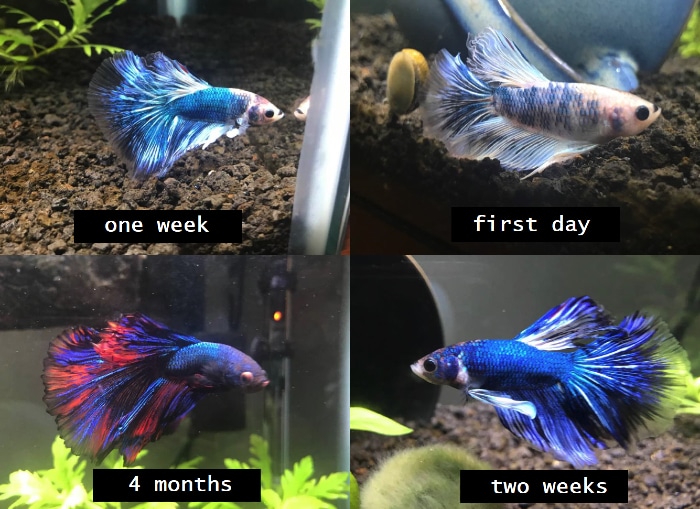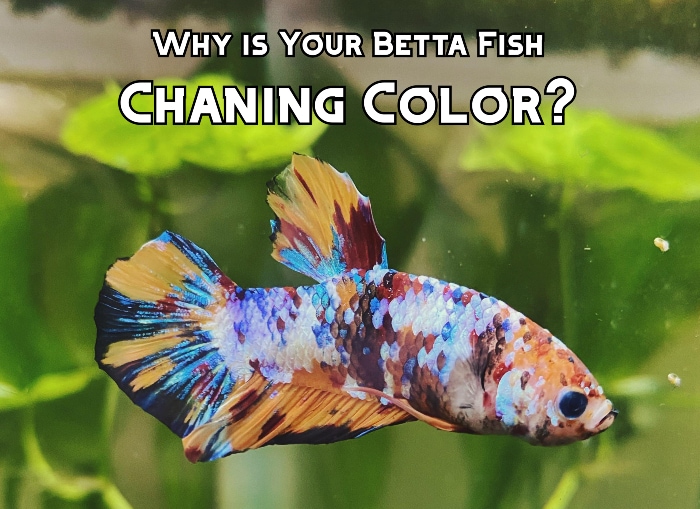In this illuminating article, we explore the reasons why Betta fish undergo transformations in their vibrant hues. Learn how to distinguish between harmless color changes such as genetics and indications of health concerns such as stress or illness. With expert insights and personal anecdotes, this article provides valuable guidance for Betta enthusiasts navigating the captivating realm of color evolution in these charismatic aquatic creatures.

One day you pass by your aquarium and you notice that something’s different. After staring at it for some time you conclude that your Betta fish seems to be changing its regular color.
That’s not something you expected to see and you have no idea why it’s happening.
How come your fish was red the other day and now half of it is blue?
What if the colors are actually fading and turning your Betta as white as a paper. Does the change signal that your fish is sick?
In this article, you’ll learn why a Betta fish changes its color and what that means.
Why is Your Betta Fish Changing Its Color?
Betta fish are widely revered for their charm, elegance, and grace.
They’re also well-known for their feisty, yet intriguing character.
However, none of these features capture our attention as strongly as their vibrant coloration.
So it’s completely natural to experience some worry when you see your beloved betta fish suddenly shift its color.
Here’s why some types of Betta fish like the Marble Betta can change their colors:
If your Betta is slowly changing its color, but appears otherwise healthy, then it likely has the Jumping Marble gene. These types of genes are also known as transposons and Marble Betta fish that have them are characterized by their splotches of random body coloration.
Due to the gene “jumping” from one location to another on a chromosome, the fish can dramatically change its color patterns multiple times throughout its lifetime. Anyway, Marble Betta fish are bred with the intention of random pigmentation transformation.
They are among the most colorful freshwater fish in the aquarium hobby. This characteristic of theirs makes them a thrilling pet to own, as you never know what the color pattern could end up like.
You may buy an albino betta for its stunning beauty, just to witness it turn into a crimson freshwater terror four months later.
In this sense, betta fish are the closest thing to a real-life pokemon you can get.
Author’s note: Pigment changes caused by the Marble gene are not harmful to your Betta fish and there’s nothing you could really do about it.
If you’re anything like me, you’ll probably just sit back and enjoy the new appearance of your fish.
Likewise, you’re also going to love the following transformations.
Have a look at this 4-month transformation of a Marble Betta:

And here’s another color transformation of a fish that had a completely white body before turning black, and orange:

Why You Should Examine Further if Your Betta is Turning White
I first need to establish the difference between a Betta that’s genetically changing its color to white and one that’s turning pale.
In the first case, the fish would have white splotches form on its body or fins.
Additionally, the newly formed splotches won’t be raised or protrude from their skin.
A pale Betta fish would have its original color hue but it will appear as if the colors are fading.

A genetic change to white is nothing to worry about as it’s just one of the many random colors a Marble Betta can acquire. However, if your Betta fish is progressively losing its color then that’s a sign of stress or illness.
Turning Pale

If the pale coloration is accompanied by lethargic behavior and laying on the bottom of the tank, then you should further examine what may be wrong with your Betta fish. The most common reasons behind these conditions are stress from sudden changes in the water parameters of the aquarium or an underlying disease.
If your Betta is also not eating then you can be certain that an illness is on the go. Your first course of action should be to test the water by using a liquid test kit to establish the exact magnitude of the problem.
Water test strips are famous for showing inaccurate results, and in this case, you’d want to know how severe the issue is. You can click here or here to see what the standard liquid test kit looks like on Chewy and Amazon respectively.
Identifying a skin condition and treating it

If your Betta has been covered by raised white spots or lesions that have their own texture then the fish likely has a skin condition. This skin condition could be caused by different species of water parasites, fungi, or bacteria.
The most common of these is what’s called freshwater Ich or White Spot Disease, a condition caused by the freshwater parasite Ichthyophthirius multifiliis.
As its name suggests, Ich can be identified by the tiny white spots that form on a fish’s body. Unlike the splotches that are typical for marble bettas, these spots actually protrude from the skin.
This is because Ich is a single-celled organism which forms cysts under the fish’s skin.
Related read: How to Treat Freshwater Ich in a Betta?
Another common ailment which may cause discoloration in Betta fish is columnaris. Columnaris is a bacterial infection caused by the Flavobacterium columnare.
The bacteria can enter a betta’s body through its mouth, gills, or a wound.
When it does, it leads to lesions over the infected fish’s body which are typically white or gray but can become yellow or brown as the infection worsens.
These lesions appear mostly on the body but might also cover the fins in some rare cases.
If the color of your Betta changes to white due to disease, treating your sick fish should become your top priority.

My Personal Advice
Bettas are magnificent fish, whether they come in an intricate or simplistic color palette.
Unlike most other fish species who remain the same once they mature, some bettas have the unique ability to change their color.
Sometimes, however, this comes at the expense of their own health.
If you’re not sure whether the color shift your betta fish is experiencing is normal, you should contact your vet.











